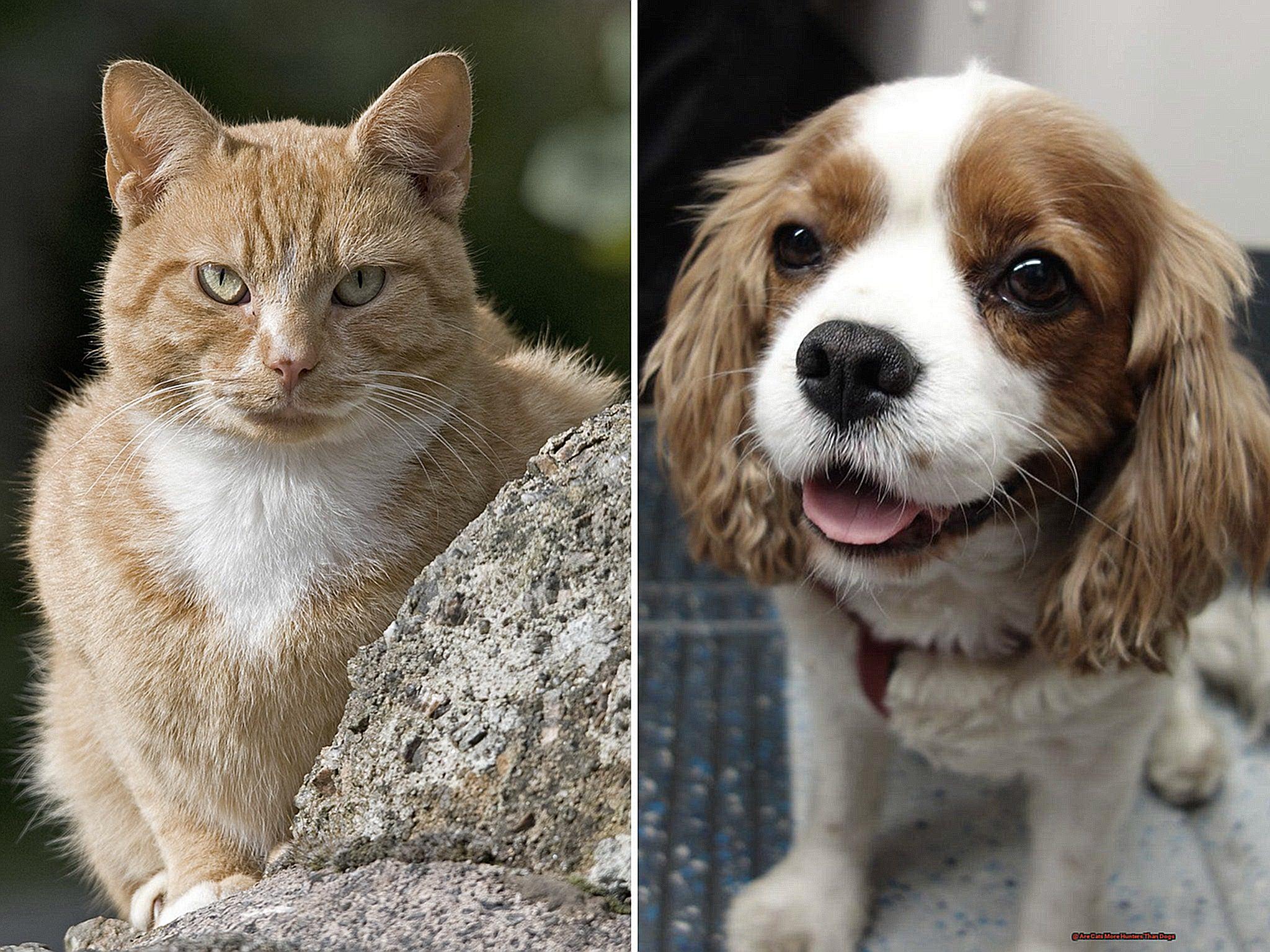As pet owners, we love our furry companions for their endless cuddles and unwavering loyalty.
But let’s not forget that beneath their domesticated demeanor lies a fierce hunter. Yes, even your lazy house cat and goofy labrador have an innate drive to stalk and capture prey.

So let’s dive into the world of hunting instincts and find out if cats truly reign supreme in this primal skill compared to dogs.
Are Cats More Hunters Than Dogs?
Contents
Let’s delve into the truth behind this common misconception and uncover the real facts about these popular pets’ hunting abilities.
First things first – cats are natural predators. They have sharp claws, keen senses, and an innate drive to hunt small prey. After all, they have been doing it for centuries. On the other hand, dogs have been domesticated for thousands of years, and their hunting instincts have been somewhat diminished. But does that automatically make cats better hunters? Not necessarily.
The truth is, both cats and dogs have their own unique hunting abilities and tactics. It all depends on their breed, environment, and training. For example, certain cat breeds, such as the Bengal and Abyssinian, are known for their exceptional hunting skills. These cats have a high prey drive and are often used in rodent control programs. Similarly, some dog breeds, like the Beagle and Terrier, have been bred specifically for hunting purposes.
One factor that may contribute to the belief that cats are better hunters is their solitary nature. Cats are independent creatures and prefer to hunt alone, making them more successful at catching prey without any assistance. In contrast, dogs are pack animals and rely on teamwork when hunting larger prey. However, this does not mean that dogs are any less skilled at hunting than cats – they just have different tactics.
Another reason why cats may seem like better hunters is because of their agility and stealth. Their flexible bodies and silent movements allow them to sneak up on their prey without being noticed. Meanwhile, dogs tend to be more vocal and may scare off potential prey with their barking. But when it comes to larger prey or hunting in groups, dogs may have the upper hand due to their size and strength.
It’s also worth noting that cats have a wider range of vision than dogs. While dogs have a more acute sense of smell, cats can see in low light conditions and have a wider field of view. This gives them an advantage when hunting in dimly lit areas or in tall grass where they can spot their prey from a distance.
Understanding Hunting Instincts in Cats and Dogs
Understanding Hunting Instincts in Cats and Dogs
Cats and dogs have been our loyal companions for thousands of years, but their natural instincts as hunters have remained deeply ingrained in their DNA. While many may believe that domesticated cats and dogs have lost their hunting abilities, the truth is that these instincts are still very much alive in our beloved pets. In this blog post, we will explore the fascinating world of hunting instincts in cats and dogs.
The Origins of Hunting Instincts
Both cats and dogs have inherited their hunting instincts from their wild ancestors. Cats, in particular, are descendants of solitary hunters like the African wildcat. These small predators had to rely on themselves to survive in the wild, which led to the development of a strong prey drive. On the other hand, dogs are descendants of pack hunters such as the grey wolf. Their pack mentality and cooperative hunting techniques have been passed down through generations, making them efficient predators.
The Prey Drive in Cats and Dogs

The prey drive is the innate desire to chase and catch prey. Cats and dogs exhibit this drive in different ways, depending on their breed and individual personality. Cats are known for their strong prey drive, which is often triggered by movement, sound, or scent. This instinct developed as a survival mechanism for cats in the wild, helping them to catch their next meal.
Dogs also have a prey drive, but it varies among different breeds. Breeds such as hounds, terriers, and retrievers have been selectively bred for their hunting abilities and thus have a stronger prey drive than other breeds. However, even within the same breed, individual dogs may have varying levels of prey drive.
Hunting Behaviors in Cats and Dogs
Contrary to popular belief, cats are not just lazy animals that sleep all day. In fact, they spend a significant amount of time hunting, even if they are well-fed house cats. This is because hunting is an essential part of their natural behavior and helps them satisfy their primal instincts. Cats use a combination of stealth, agility, and patience to hunt their prey. They stalk and wait patiently for the right moment to pounce on their unsuspecting victim.
Exploring the Differences in Physical Traits Between Cats and Dogs for Hunting
Exploring the Differences in Physical Traits Between Cats and Dogs for Hunting
When it comes to hunting, cats and dogs are two of the most skilled predators in the animal kingdom. But have you ever wondered why they have such distinct physical traits? In this section, we will take a deep dive into the fascinating differences in physical characteristics between these two animals, and how they have evolved to suit their respective hunting styles.
Evolutionary Backgrounds: Solitary Hunters vs. Pack Hunters
One of the main factors that contribute to the physical differences between cats and dogs is their evolutionary backgrounds. Cats, such as the domestic house cat, descended from solitary hunters like the African wildcat. On the other hand, dogs, including our beloved pet dogs, descended from pack hunters like wolves.
As a result, cats have a slender and agile body, while dogs have a muscular and powerful build. This difference in body structure is essential for their hunting styles, which we will explore further below.
Agility vs. Speed and Endurance
Cats are well-known for their agility and flexibility, which allows them to climb and jump with ease. Their flexible spine and hind legs that can rotate give them the ability to move swiftly and silently. This makes them excellent climbers and hunters of small prey that may be hiding in trees or on rooftops.
On the other hand, dogs are built for speed and endurance. They have a more rigid spine and hind legs that primarily move forward, giving them the ability to run and chase after prey on the ground. This makes them ideal for hunting larger prey or covering long distances while tracking.
Claws: Retractable vs. Non-Retractable
Another notable difference between cats and dogs is their claws. Cats have retractable claws that they can extend when needed for climbing, hunting, or defense. This also allows them to walk silently, making it easier for them to sneak up on prey.
Dogs, on the other hand, have non-retractable claws that are ideal for digging and gripping prey while running. These claws are also essential for their pack hunting style, where they work together to take down larger prey.
Breed-Specific Hunting Abilities: Are Certain Breeds Better Hunters?
On the other hand, dogs may also showcase their hunting abilities by chasing after squirrels or retrieving a ball. But are certain breeds better hunters than others?
The short answer is yes. Certain cat and dog breeds have been bred for their hunting abilities and still possess strong instincts for tracking, catching, and killing prey. Breeds such as the Siamese and Bengal cats are known for their exceptional hunting skills. These cats were originally bred for their agility and speed, making them excellent hunters of small prey like mice and birds.
Similarly, certain dog breeds like the Greyhound and Beagle have been selectively bred for their hunting prowess. These breeds excel in chasing and retrieving prey, with the Greyhound being known as one of the fastest dog breeds.
However, it’s important to note that not all cats and dogs of these breeds possess the same level of hunting skills. While genetics play a significant role, training and environment also play a crucial part in honing an animal’s hunting abilities. A well-trained cat or dog can develop and refine their natural instincts through practice and guidance.
Other factors that can affect a cat or dog’s hunting abilities include age, health, and socialization. Older animals may not be as agile or quick as younger ones, while health issues can also hinder their physical capabilities.
Socialization can also play a role in an animal’s hunting skills as those who are familiar with their surroundings and have been exposed to different stimuli are more likely to display successful hunting behaviors.
It’s also worth noting that domestication has somewhat diminished these natural instincts in both cats and dogs. While they may still have the drive to hunt, they may not necessarily have the skills or opportunity to do so in a domestic setting.
This is why it’s crucial for pet owners to provide their animals with outlets for their natural behaviors, such as interactive toys and playtime.
Furthermore, different breeds may have varying levels of prey drive. For instance, terriers are known for their strong prey drive and may be more inclined to hunt than other breeds. It’s also important to consider the type of prey that cats and dogs are inclined to hunt. Cats are solitary hunters and tend to go after smaller prey, while dogs are pack hunters and can take down larger prey.
Environmental Factors That Influence a Cat or Dog’s Hunting Abilities
As pet owners, we are all familiar with our furry companions’ playful antics and their occasional hunting behaviors. Whether it’s our cat pouncing after a laser pointer or our dog chasing after a ball, it’s clear that our pets have an innate drive to hunt. But have you ever wondered what factors influence their hunting abilities?
Domestication and Breeding
Cats and dogs have been domesticated for thousands of years, but the process of domestication for each species has been different. Cats, being natural predators, were initially domesticated for their hunting abilities to control rodent populations. Over time, they have adapted to living with humans and have developed a variety of hunting skills in different environments.
Dogs, on the other hand, were domesticated for specific purposes such as hunting, herding, or guarding. This selective breeding has influenced the hunting abilities of different dog breeds. For example, hounds were bred for their exceptional sense of smell and tracking skills, while terriers were bred for their agility and ability to dig and catch small prey.
Habitat and Climate
The environment in which cats and dogs live also plays a significant role in shaping their hunting abilities. Cats, being smaller and more agile, can thrive in a variety of landscapes and climates. They are able to adapt quickly to changes in their environment, making them effective hunters in both urban and rural settings.
Dogs, on the other hand, are less adaptable to different environments due to their larger size. They rely on their human owners for food and shelter, making them less independent hunters than cats. However, certain dog breeds can still excel in hunting in specific environments. For example, retrievers are known for their ability to hunt waterfowl in wetlands, while sighthounds are skilled at chasing prey in open fields.
Prey Availability
Another significant factor that influences a cat or dog’s hunting abilities is prey availability. Cats, being opportunistic hunters, can survive on a wide range of prey, including insects, small mammals, and birds. Their sharp senses and flexible body movements make them efficient predators in any environment.
Dogs, on the other hand, have been selectively bred to hunt specific types of prey. This means they may be less adaptable to changes in prey availability. For example, a dog trained to hunt rabbits may struggle to catch a bird if there is a sudden decrease in rabbit populations.
Comparing the Hunting Strategies of Cats and Dogs
While they may both be our beloved domesticated companions, their hunting strategies are vastly different. In this article, we’ll dive into the various factors that influence the hunting techniques of cats and dogs.
Evolutionary Background:
Cats and dogs have a long history of evolution, with cats being traced back to their wild ancestor, the African wildcat, and dogs originating from wolves. This evolutionary background plays a significant role in their hunting strategies. Cats, being solitary hunters, have retained their hunting instincts from their wild ancestors. On the other hand, dogs, being pack animals, have adapted their hunting techniques to work together with their pack.
Domestication:
The domestication of cats and dogs has also played a significant role in shaping their hunting abilities. Cats were first domesticated in ancient Egypt to control pests, while dogs were domesticated for their hunting and protection skills. As a result, cats have retained their solitary hunting nature, while dogs have been trained to work together with humans for hunting purposes.
Sensory Abilities:
Cats and dogs have different sensory abilities that aid them in hunting. Cats have highly developed senses of sight, hearing, and smell, which they use to stalk and ambush their prey. Their excellent night vision allows them to hunt effectively even in low light conditions. On the other hand, dogs rely more on their sense of smell to track and chase prey. Their strong sense of smell is due to the large number of olfactory receptors in their nose.
Physical Capabilities:
When it comes to physical capabilities, cats and dogs have distinct advantages in hunting. Cats have sharp claws and teeth that they use to capture and kill prey quickly. Their flexible bodies and agile movements also allow them to sneak up on prey without being detected. On the other hand, dogs use their strong jaws to hold onto prey while hunting. They also have a more significant endurance and stamina, making them capable of chasing prey for longer periods.
Prey Preferences:
Cats and dogs have different preferences when it comes to their prey. Cats are known for hunting small animals like rodents and birds, which they can easily overpower with their agile movements. On the other hand, dogs can take down larger prey like deer or wild boar, making them better suited for hunting in packs.
The Role of Training in Enhancing a Cat or Dog’s Hunting Skills
It’s no secret that both of these furry creatures possess natural hunting abilities. However, with proper training, these instincts can be further enhanced to make them skilled hunters.
Cats have been domesticated for their hunting abilities for centuries. In fact, their ancestors were revered for their ability to control rodent populations. This innate hunting instinct is still present in our modern-day house cats, as their sharp senses and agile bodies make them excellent hunters. On the other hand, dogs have been domesticated for different purposes such as guarding, herding, and hunting. While some breeds may have a stronger hunting instinct than others, all dogs possess some level of this instinct.
So how can you train your cat or dog to become even better hunters? It all starts with teaching them the basic skills of stalking, pouncing, and retrieving. This can be done through play or using specific toys designed for hunting. Positive reinforcement techniques, such as treats and praise, can also be used to encourage and reward good hunting behaviors.
It’s important to start training at a young age for both cats and dogs. This allows them to learn and adapt to different environments and prey. While cats may have a more natural inclination towards hunting, dogs can also be trained to become equally skilled hunters through consistent training and reinforcement.
Some breeds of dogs, such as terriers and hounds, are known for their exceptional hunting abilities due to their breeding history. However, training plays a crucial role in enhancing these natural instincts even further.
Not only does training make your cat or dog a better hunter, but it also helps control their hunting behavior. It teaches them boundaries and prevents them from harming other animals or bringing unwanted prey into the house.
Conclusion
In conclusion, it is undeniable that both cats and dogs possess a strong instinct to hunt. Despite being domesticated for different purposes, their innate drive to catch prey remains deeply ingrained in their DNA. Through centuries of evolution and selective breeding, these furry companions have developed unique hunting abilities and techniques.
While the general belief may be that cats are superior hunters compared to dogs, the reality is that both species excel in their own ways. Cats’ solitary nature and agility make them adept at catching small prey, while dogs’ pack mentality and endurance make them ideal for chasing down larger animals.
Various factors such as genetics, training, environment, and availability of prey all contribute to shaping a cat or dog’s hunting prowess. And although domestication may have somewhat diminished these natural instincts, proper training can help enhance them even further.
As responsible pet owners, it is crucial to understand our furry friends’ inherent desire to hunt and provide them with appropriate outlets for this behavior. Whether it be through interactive toys or structured training sessions, we can satisfy our pets’ primal instincts while also ensuring their safety.






